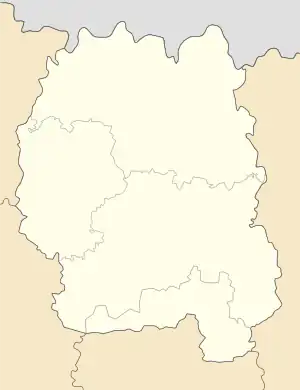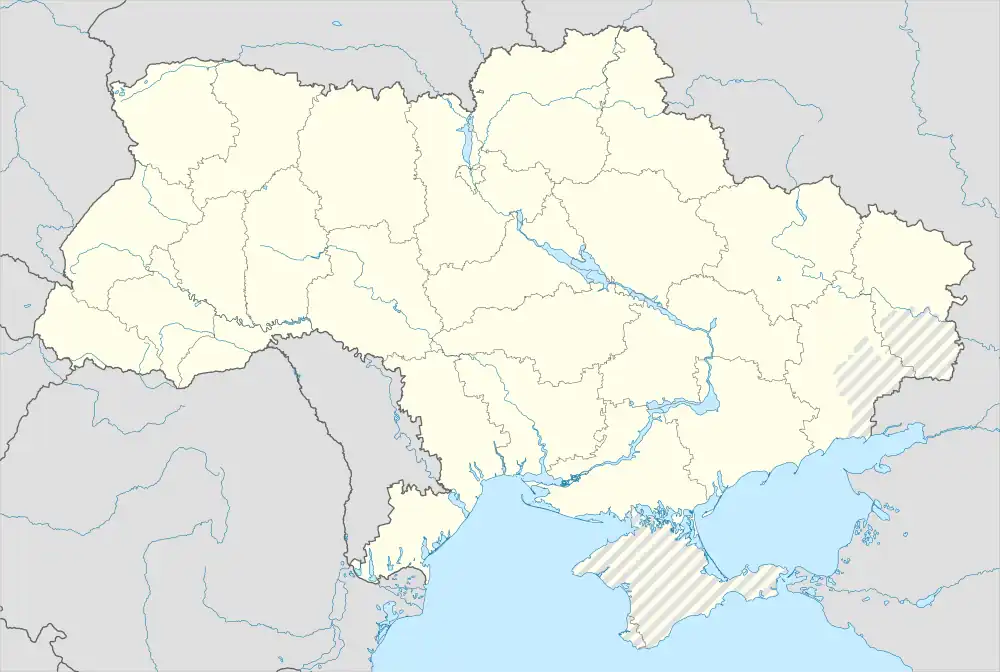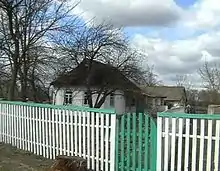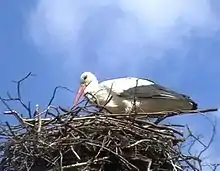Kotliarka
Котлярка Kotlyarka | |
|---|---|
 Kotliarka  Kotliarka | |
| Coordinates: 50°01′40″N 29°19′55″E / 50.02778°N 29.33194°E | |
| Country | |
| Oblast | |
| Raion | |
| First mentioned | 1700s |
| Government | |
| • Type | Village Council |
| • Body | 12 |
| • Chairman | Nelia Nazaruk[1] |
| Area | |
| • Land | 2.37 km2 (0.92 sq mi) |
| Elevation | 210 m (690 ft) |
| Population | |
| • Total | 429 |
| • Density | 181/km2 (470/sq mi) |
| Time zone | UTC+2 (EET) |
| • Summer (DST) | UTC+3 (EEST) |
| Postal code | 13523 |
| Area code | +380 4137 |
Kotliarka or Kotlyarka (Ukrainian: Котлярка [kotˈlʲɑrkɐ]) is a village in Ukraine, located in the Zhytomyr Raion of the Zhytomyr Oblast (province).[2] The village belongs to an eponymous village council - the Kotliarka village council.
The name of the village might be derived from the Ukrainian word kotliar (Ukrainian: котляр), which means 'boilermaker'.
In 2014, according to the Popilnia Raion Council, the village population was 429 people (204 men and 225 women) of 261 households.
There are a kindergarten, school, community club, library, medical assistant's, post office, 2 retail shops, cafe, place of worship in the village.[3]
Geography
The village is situated in the North-West of the Dnieper Upland and the historical region Right-bank Ukraine.
The village council area borders the Andrushivka Raion in the west and village councils of the Popilna Raion: Lypky in the east, Khodorkiv in the north, Sokilcha in the south-west, Velyki Lisivtsi in the south and Myroliubivka in the south-east.
The very small river Kryvenka (Ukrainian: Кривенька, English: Curved) flows through the village and falls into the Unava River, which flows into the Irpin River of the Dnieper basin by its turn. There is a pond on the river in the village, that is called the Kryvenka Reservoir.[4]
Two not too big forests are near the village towards Markova Volytsіa and Liubymivka villages. They were parts of a large forest[5] in the Popilnia Raion, that forest was significantly cut down because of the intensive potash production in 14th - 19th centuries there, which needed a lot of wood.[6][7][8]
By roads, the village is located:
- 14 km to the nearest railway station Yaropovychi.
- 15 km to the district centre Popilnia.
- 58 km to the region centre Zhytomyr.
- 138 km to the capital of Ukraine Kyiv.
- 153 km to Boryspil International Airport.
There are Highway R 18 (Р18, Zhytomyr - Skvyra - Stavyshche) and Highway T 0605 (Kotliarka - Korostyshiv - Olevsk - the State Border of Ukraine with Belarus) going through the western part of the village.
First language of the villagers according to the Ukrainian Census (2001)[9]
History
Early time
Next to the village, Serpent's Walls[10] and ancient kurgans[11] were found. The Ukrainian historian Volodymyr Antonovych mentioned the village in his work "The archaeological map of the Kiev Governorate" 1895.[12] He marked 2 large and 12 small kurgans in 3 kilometres from the village.[13]
Before the Kievan Rus epoch it was a territory of Eastern Polans and approximately 8 kilometres to the north, on the left bank of the Irpin River Drevlians' land began.[14]
At the time of the Kievan Rus and the Grand Duchy of Lithuania this land belonged to the Principality of Kiev. There were no allusions about any permanent human settlements in there, which can be associated with the modern village Kotliarka, at that time.
Kingdom of Poland period
After the Union of Lublin this territory was a part of the Zhytomyr Povit (Powiat) of the Kiev Voivodeship of the Crown of the Kingdom of Poland of the Polish–Lithuanian Commonwealth.
In 1648 - 1714 the land of present Kotliarka village belonged to the Khodorkiv Sotnia of the Pavoloch Regiment of the Cossack Hetmanate.
The village is mentioned in a history of 1753 year, there was an alleged ritual murder of a nobleman's child by Jews in the nearby village Markova Volytsіa. The investigation was led directly by the Bishop of Kiev of the Roman Catholic Church Kajetan Sołtyk. One of the accused of the crime was the arendator Moysha from Kotliarka, who was dismembered in Zhytomyr in the end.[15] This story was included into the book "About the meaning and significance of blood sacrifice" by the theologist Timofei Butkevich,[16] who was one of the founders of the Black Hundreds movement - "Russian Assembly".
Russian Empire period

After the Second Partition of Poland in 1793 the village went to the Russian Empire and since 1796 the village belonged to the Kiev Governorate.
The ethnographer Lavrentii Pokhylevych in his work "Tales of inhabited areas of the Kiev province" mentioned the village. In 1835 Kotliarka belonged to the Skvyra Povit (Uezd) and the parish of the Holy Dormition church in the neighbour village Sokilcha. The owners of the village were descendants of August Slyvynsky. There were 520 Orthodox Christians and 100 Catholics in the village.[17]
In the middle of the 19th century, according to the registry books of the Holy Dormition church, there were the following names: Makarchuk, Vlasiuk, Sydorchuk, Motsak, Starunsky, Pastushenko, Stetsenko, Ovdiushka, Artemchuk, Kubdiak, Ivaniuk, Kolysnychenko, Yakovchuk, Okseniuk and Pavlenchuk distributing among villagers.[18]
In 1878–1879, the riot of chynshovyks (quit-renters), who were tenants and former noblemen, was breaking out in the village. The chynshovyks seized back the land that had previously rented them from the landlord Slyvynsky for quit-rents. The land had been taken on lease by a sugar company from Khodorkiv for the high rental payment. After police arrested the riot organiser Baladinski, he was released by about forty his fellows, who were armed with clubs. The police managed to stop the riot, there were 26 rebels arrested, they subsequently got various terms of imprisonment. However, the landlord was advised to refrain from attempts to change the tenants of the land.[19]
According to the Russian Empire Census in 1897[20] the rural population of the Skvyra Povit, consisted of 86.65% Ukrainian, 9.69% Jewish, 2.51% Polish and 0.95% Russian speaking people.
Soviet era

At the time of the Ukrainian People's Republic from 1918 to 1919 Kotliarka was a part of the Bolokhiv Land according to the administrative division of Ukraine (1918).
In 1920 the general staff of Bolsheviks' 1st Cavalry Army was situated in the village.
As a result of the Ukrainian–Soviet War (1917–1921) and the Polish–Soviet War (1919–1921) Right-bank Ukraine, including the village, was finally captured by the Red Army.
After the Treaty on the Creation of the USSR in 1922, the village came into the Popilnia Raion of the Zhytomyr Okruha of the Ukrainian Soviet Socialist Republic.
There were names of 101 victims of the Holodomor 1932-1933 ascertained on the basis of the stories of the eyewitnesses S. Babych, P. Vilchynska, Y. Zavadska, S. Monastyretsky and S. Sokyrko.[21]
Since the formation of the Zhytomyr Oblast in 1937, the village has belonged to it.
During the Political repression in the Soviet Union, especially in the Great Purge, a lot of villagers were being executed or deported. Ethnic Ukrainian families: Babych, Blinkevych, Ivaniuk, Kyianchuk, Mozharivsky, Savchuk, Syvkovych, Tkach, Vazytsky, Vitkivsky and Polish families: Baladinski, Czopiwski, Dimovicz, Drenczik, Kaszperski, Mozarowski, Rowinski, Rudnicki, Smogorzewski, Werpachowski, Wilczinski, Zawadski were subjected to repression.[22]
Many villagers were conscripted into the Red Army and killed during the Winter War (Soviet-Finnish War 1939–1940).[23]
During the Nazi occupation of 1941-1943[24] the village was in the Ruzhyn Gebiet of the Zhytomyr General Okruha of the Reichskommissariat Ukraine.
150 villagers fought in the Red Army in World War II, 82 of them died and 63 were awarded orders and medals. In 1954, the monument to fallen soldiers was erected.
Businesses
- A brick factory of "Sunway Trade LTD".[25]
Farms:[26]
- Norok
- Natali
- Kotliarka
- SVAROG-AGRO
Prominent people
- Grygorii Motsak - a Hero of Socialist Labor, member of the Supreme Soviet of the Soviet Union of 8-11 convocations.
- Leonid Monastyretsky - an Honored education worker of Ukraine, professor of modern Ukrainian literature and social communication of the University of Zhytomyr.[27]
- Roman Okseniuk - a historian, ethnographer of Volhynia, docent and head of the department of history of the Lesya Ukrainka East European National University.[28]
- O.M. Tkachuk, I.I. Verpakhivsky - holders of the Order of Lenin.
- B.M. Rudnytsky, A.M. Koval, M.A. Solsky, V.P. Shynkarenko holders of the Order of the Red Banner of Labour
- Valentyna Nazaruk - a Mother Heroine[29]
- Petruk Tetyana - a Mother Heroine[30]
References
- ↑ Leaders of the Kotliarka village council // Popilnia Raion council
Ukrainian: Керівництво Котлярської сільської ради - ↑ Kotliarka // The History of Cities and Villages of the Ukrainian SSR
Ukrainian: Село Котлярка, Попільнянський район - ↑ Socioeconomics of Kotliarka village // Popilna Raion Council
Ukrainian: Соціально-економічна характеристика села Котлярка - ↑ Kotliarka // mistaUA
Ukrainian: Котлярка, Попільнянський район, Житомирська область, Україна // mistaUA - ↑ Military Topographic Map of the Russian Empire 1846-1863
Russian: Военно-топографическая карта Российской Империи 1846-1863 гг. - ↑ Calaméo - H. Shvydko // History of Ukraine, XIV - XVII
Ukrainian: Г. К. Швидько. Історія України. 8 клас - ↑ Rural crafts and trades in Ukraine, XVI - XVII
Ukrainian: Сільські ремесла і промисли України у другій половині XVI — першій половині XVII ст. - ↑ History // Popilnya village council
Ukrainian: Історія // Попільнянська селищна рада - ↑ Table: 19A050501_02_018. Distribution of the population by native language, Zhytomyrska oblast (1,2,3,4)
- ↑ Cultural heritage Protection // Popilnya Raion Central Library Archived 2016-08-21 at the Wayback Machine
Ukrainian: Охорона культурної спадщини - Попільнянська центральна районна бібліотека - ↑ O. M. Ivashchenko // Historical and Cultural Monuments and Memorials in Zhytomyr Region (Popilnya Raion), Issue 9 // Zhytomyr, 2007 // p. 174-177. ISBN 978-966-655-267-2
Ukrainian: Іващенко О. М. Пам'ятки і пам'ятні місця історії та культури на Житомирщині (Попільнянський район). Випуск 9. — Житомир, 2007. — с. 174—177. ISBN 978-966-655-267-2 - ↑ National Historical Library of Ukraine
Ukrainian: Національна історична бібліотека України - ↑ V. Antonovych // The archaeological map of the Kiev Governorate, 1895 // Kotliarka
Russian: В. Антонович. Археологическая карта Киевской губернии 1895, Котлярка - ↑ The origin, distribution and social order of the Slavs in VI - IX centuries. - History of Ukraine // Online study materials
Ukrainian: Походження, розселення та устрій слов'ян у VI - IX ст. - Історія України - Навчальні матеріали онлайн - ↑ Saints from Pavoloch, Besht and collective memory // Lechaim Archived 2016-08-16 at the Wayback Machine
Russian: СВЯТЫЕ ИЗ ПАВОЛОЧИ, БЕШТ И КОЛЛЕКТИВНАЯ ПАМЯТЬ // Lechaim - ↑ About the meaning and significance of blood sacrifice // T. Butkevich
Russian: О смысле и значении кровавых жертвоприношений - ↑ Tales of inhabited areas of the Kiev province 1884, page 223 Archived 2017-04-26 at the Wayback Machine
Russian: Сказанія о населенныхъ мѣстностяхъ Кіевской губерніи - ↑ The Skvyra Povit of the Kiev Governorate // Registry Books Archived 2016-09-10 at the Wayback Machine
Russian: Сквирский уезд Киевской губернии :: Украина, условно Центр :: Украина (Україна) :: СТРАНЫ И РЕГИОНЫ - ↑ The battle for land in Ukraine 1863-1914. Daniel Beauvois
Ukrainian: Розділ III. Даніель Бовуа. Битва за землю в Україні 1863-1914. - ↑ Breakdown of population by mother tongue and districts in 50 Governorates of the European Russia at Demoscope Weekly, project by National Research University – Higher School of Economics
- ↑ The Popilnia Raion // National memory book of Holodomor victims 1932-1933 in Ukraine
Ukrainian: Попільнянський район // Національна книга пам'яті жертв Голодомору 1932—1933 років в Україні - ↑ "Житомирська область // © Головна редакційна колегія науково-документальної серії книг «Реабілітовані історією», Український інститут національної пам'яті" [Zhytomyr Oblast // Ukrainian Institute of National Remembrance]. Retrieved 2023-05-25.
- ↑ Soviet-Finnish War 1939-1940 Archived 2016-08-07 at the Wayback Machine
Russian: Советско-финская война (1939—1940) - Лановцы и Примы - наши корни - ↑ Хроніка вигнання нацистських окупантів з України (1942 – 1944рр.) [The chronicle of expulsion of the Nazi occupants from Ukraine] (PDF) (in Ukrainian). Kyiv: National Museum of the History of Ukraine in the Second World War.
- ↑ UAMaps.biz // Your business
Ukrainian: ФІЛІЯ ЦЕГЕЛЬНИЙ ЗАВОД ТОВАРИСТВА З ОБМЕЖЕНОЮ ВІДПОВІДАЛЬНІСТЮ САНВЕЙ ТРЕЙД - ЖИТОМИРСЬКА ОБЛ., ПОПІЛЬНЯНСЬКИЙ Р-Н, С.КОТЛЯРКА ВУЛ. ЛЕНІНА БУД. 80 - адреса, телефон, контакти, відгуки - ↑ Котлярка — search for UA-region | Ukrainian enterprises. Ukrainian companies. Catalogue of companies of Ukraine — Kyiv, Kharkiv, Donetsk, Dnipropetrovsk, Odesa, Lviv
- ↑ The news of Zhytomyr - Leonid Monastyretsky has passed away // Zhytomyr Reporter Archived 2016-08-17 at the Wayback Machine
Ukrainian: Новини Житомира - Пішов із життя Леонід Монастирецький - Репортер Житомира - ↑ Roman Okseniuk Archived 2016-08-20 at the Wayback Machine // Volyn Oblast council
Ukrainian: Оксенюк Роман Назарович, romanized: Волинська обласна рада - ↑ About the title Hero Mother awarding // Verkhovna Rada
Ukrainian: Про присвоєння почесного звання Мати-героїня., romanized: від 27.01.2010 № 74/2010 - ↑ About the title Hero Mother awarding // Verkhovna Rada
Ukrainian: Про присвоєння почесного звання Мати-героїня., romanized: від 27.01.2010 № 74/2010